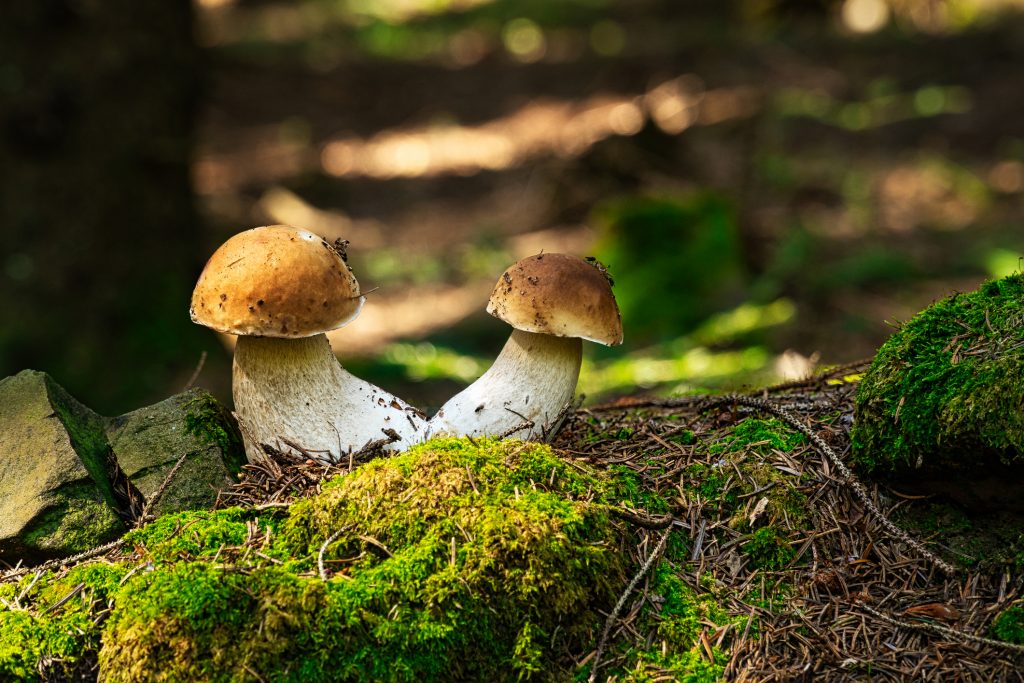Porcini mushrooms are a valuable ingredient in both French and Italian cuisine. They can be added to pasta or risotto or used as a side dish on their own.
Like morels or truffles, these fungi are almost exclusively harvested from the wild. They would be very difficult and time-consuming to grow commercially since they require a symbiotic relationship with the roots of specific types of trees.
Fresh porcini mushrooms are a gourmet item mostly reserved for use by chefs. However, dried porcinis are exported around the world and are more widely available. (If you’re interested in cooking with porcinis or other mushrooms, check out some of our favorite mushroom recipes.)
In this complete guide to porcini mushrooms, we’ll explain what porcini mushrooms are, as well as what they look and taste like. By the end you’ll know where porcinis grow or can be purchased. We’ll explain how to select, clean and cook porcinis. Plus you’ll learn about their health benefits and more.
What Do Porcini Mushrooms Look Like? (How to Identify Them)
Porcini mushrooms have brown semi-circle shaped convex caps and thick white stalks. They look a bit like a king oyster mushroom. In fact, they are referred to as the king bolete in some places.
Most porcini mushrooms are a couple of inches/ around 5 centimeters tall. However they can range anywhere from an inch/ 2.5 centimeters or smaller up to almost a foot/ 30 centimeters in size. Caps can also grow as large as a foot/ 30 centimeters across and weigh up to two pounds/ about a kilogram. More mature mushrooms will have dark brown caps with white edges, which is why they’re sometimes called penny buns in the UK. The cap will be slightly sticky when wet.
Stems of porcini mushrooms are cylindrical and have a faint netting pattern and they’re very white. When you cut into them, the color should stay white and not change at all. The surface of porcini mushrooms also won’t bruise or become discolored with handling. This can help to differentiate real porcinis from other lookalikes. The base of a porcini mushroom stem is very wide and it narrows toward the cap.
Porcinis will produce a brown spore print if put on a piece of paper overnight.
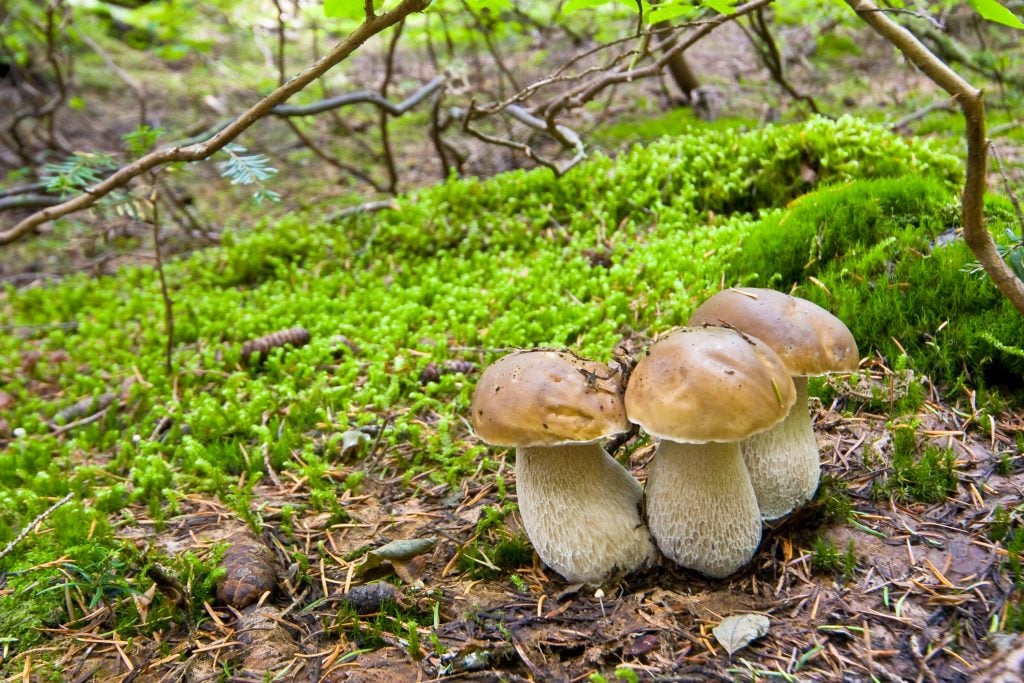
Porcini Mushroom Look-Alikes
There are some mushrooms that could be confused for the porcini mushroom. Luckily they are fairly uncommon and none of them are deadly poisonous. The worst you’ll likely end up with from eating one is a bad stomach ache.
However, many porcini lookalikes are bitter and unpalatable. Any recipe you try to use them in will be rendered inedible. So it’s worth learning to avoid them even if it’s not a matter of life and death.
False Bolete (Boletus huronensis)
At first glance, the false bolete can look like a real porcini mushroom. However there are a few telltale signs that give it away.
While its cap looks similar to a porcini, the outer edge tends to roll inward.
Underneath the cap, a false bolete looks spongy like a porcini. However the color is more of a yellow or off-white instead of a pure white. The big giveaway is that it will bruise when touched or scraped. Starting with a blue or green color and eventually ending up brown or red.
The stem and flesh of the false bolete will also bruise a blueish color when handled.
A false bolete’s stem will often be white at the top like a porcini, but it changes to a darker brown hue about halfway down the stem. The stem also lacks the netting pattern present on real porcinis.
The edibility of false boletes is up for debate. Some people say it has a sweet taste while others describe it as skunky or a garlicky flavor. We recommend avoiding it.
Bay Bolete (Imleria badia)
The bay bolete is another mushroom that looks similar to a porcini. It’s in the same family of mushrooms and may be easily confused with a porcini. Their sizes and overall shapes are similar.
The big giveaway is that bay boletes are more reddish colored than porcinis. Both the cap and stem will be more of a red color, as opposed to the white stem of a porcini.
When you cut into the cap or stem of a bay bolete, the flesh will turn slightly blue which is another clear giveaway. Touching a mature bay bolete will stain your hand a blueish color.
The bay bolete is considered edible. Its flavor isn’t as enjoyable as a porcini and the texture is less firm. However you may still choose to eat them anyway if you come across them.
Bitter Bolete (Tylopilus felleus)
While the bay bolete tends to be a reddish color, the bitter bolete is more of an orange or tan color.
When mature, the bitter bolete’s cap can look brown like a real porcini and it even has a white edge like the real thing.
Early on, the pores of a bitter bolete are white, but turn pinker as it reaches maturity. It will also produce a pink spore print.
The flesh of a bitter bolete is white and doesn’t bruise. This makes it a lot harder to distinguish from real porcini compared to other lookalikes that tend to bruise blue.
If you’re unsure, a quick taste test should easily help you to decide if you’re dealing with a real porcini or not. As the name suggests, the bitter bolete is indeed quite bitter.
While it’s not poisonous, bitter boletes will certainly ruin any pasta or risotto dishes that you put them in. So it’s worth trying a small piece before adding it to any recipe.
Devil’s Bolete (Rubroboletus satanas)
One rare poisonous bolete to look out for is the aptly-named devil’s bolete or satan’s bolete.
While it has the same overall shape of a porcini, the obvious giveaway is the bright red stem. Cutting into the flesh will cause it to bruise blue.
This mushroom will cause violent nausea and vomiting if eaten, so it’s best to avoid any mushrooms you come across that fit this description.
When in doubt, always consult an expert before consuming any wild mushrooms that you come across.
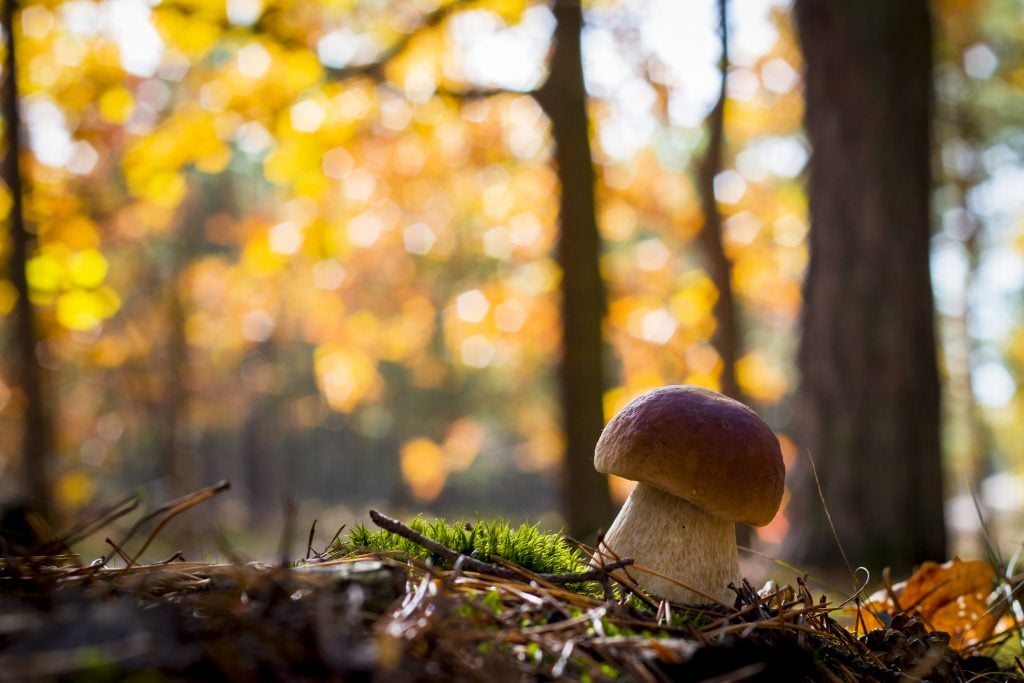
Where Do Porcini Mushrooms Grow?
Porcini mushrooms and other boletes grow wild in forests all throughout the Northern Hemisphere. They’re particularly common in Italy, but you can find them across various parts of Europe, North America and Asia.
Porcinis are mycorrhizal mushrooms. That means they form a symbiotic relationship with the roots of plants. Trees in particular in this case. They tend to be found paired with areas that have birch or beech trees, as well as conifers like spruce, pine, fir and hemlock. It’s more rare to find porcini mushrooms around oak or chestnut trees, but it does happen.
Are you interested in growing your own mushrooms? Check out How To Grow Mushrooms: The Ultimate Guide in our Resource Hub.
Tricks for Finding Wild Porcini Mushrooms
When it comes to hunting for wild mushrooms, location is everything. Some people even have secret locations where they gather mushrooms year after year. Porcini mushrooms are no exception.
Porcinis can be hard to find because their brown cap can blend in with leaves on the ground. If you aren’t careful, you might pass over them. You’ll want to check around any strange bunches of leaves, as mushrooms can often be hidden underneath them.
There are a few things you can do to improve your chances of finding porcinis.
Porcinis like to grow around the roots of trees. They’re most often found around birch and beech trees in particular. So rather than searching the entire forest for mushrooms, you may want to identify these specific types of trees first and narrow your search around them.
It’s easier to spot porcinis if you see them from the side instead of above. So try to look further ahead instead of right at your feet.
Porcini mushrooms like to grow in places where the sun is able to reach the ground. So pay special attention in more open and sunny areas of the woods.
Ferns really prefer acidic soil and porcinis don’t. So if you come across an area with lots of ferns, there’s no point to look for porcinis in that area.
Where you find one porcini there’s usually more. So step carefully to avoid walking on any other mushrooms in the area.
When Are Porcinis In Season?
Most porcinis are found in autumn between September and November. This is when their size and flavor will be at their best. However there’s also a short growing season for porcinis between March and April in most locations. A good, humid spring will ensure a strong harvest in the fall.
Depending on where you live, you might even be able to find porcini mushrooms starting in June.
You can find porcini mushrooms at markets and in stores when they’re in season. You can find dried porcini all year round.

How to Harvest Porcinis
When collecting porcinis, you want to cut them at the base with a sharp knife, as close to the ground as possible.
If you don’t have a knife, then you can gently twist them out of the ground with your hand, though be careful to pull out any of the root system that support them.
Avoid overpicking mushrooms. Leave any that are too large and mature. They won’t be as good for eating, and letting them fully mature and release their spores will help spread more porcini mushrooms around the forest.
Similarly, leave the smallest porcinis. If you’d like, you can come back a few days later to harvest them when they’re larger. Generally speaking, you should always be respectful and cause as little disruption to the environment as possible.
For information about how to preserve mushrooms after harvesting them, read our article on freezing mushrooms.
Cleaning Porcini Mushrooms
A downside to harvesting wild mushrooms is all of the other bits of nature that come along with it.
Porcinis aren’t just tasty to humans. Lots of worms and other little insects like to eat them as well. So you should check them very carefully during the cleaning process if you want to avoid eating bugs! If your porcini caps have a lot of little holes from worms and maggots, you may want to pass on them entirely.
One common trick is to place porcini mushrooms upside-down on a piece of newspaper for a few minutes. If there are any pests in the mushrooms, the smell of the paper will make them come out.
Any large bits of soil or dirt can be brushed off the mushroom with your hand. Particularly hard bits can be scraped off with a knife.
Porcinis are a very spongy mushroom that you don’t want to soak in water as they’ll absorb too much of it. You don’t even want to rinse them off if you can avoid it.
Instead, use a slightly damp cloth to wipe any remaining dirt off just before cooking them.
You can cook porcini mushrooms whole, or you can twist the caps to separate them from the stems. Some prefer to only use the more tender caps for cooking. Stems are better if sliced thinly, or blended up for use as a filling or in a mushroom soup.
How to Store Porcini Mushrooms
Fresh porcini mushrooms should be stored unwashed in a paper bag in the fridge. They’ll stay fresh for a couple of days, but the sooner you’re able to cook them the better.
If you’ve harvested a large amount of porcini, you’ll want to preserve any that you can’t use immediately. You can either dehydrate them or blanch them for freezing.
Keep dried porcinis in an airtight container and put them in a cool dark place. They will stay fresh for up to six months. For more information on keeping mushrooms fresh, check out our article on how long mushrooms last.
What Do Porcini Mushrooms Taste Like?
Porcini mushrooms can be summed up in three words: Nutty, earthy and meaty.
They’ve got a more firm and meaty texture than common button mushrooms. They add a rich, deep flavor to recipes. Dried porcinis tend to be slightly chewy once rehydrated.
You can think of them kind of like the “wild game” counterpart to cultivated mushrooms like portobellos. Porcinis have a stronger, wilder flavor.
If you’ve ever had shiitake mushrooms before, we think that’s the type of mushroom that tastes most similar to porcini.
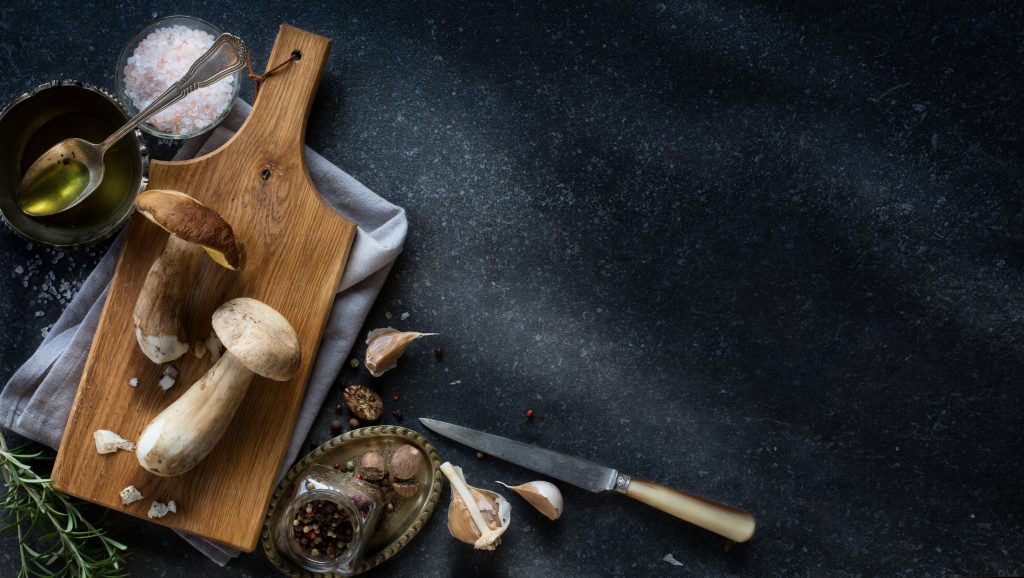
How to Cook With Porcini Mushrooms
If you’re starting off with dried porcini, you’ll need to rehydrate them before you can cook with them. To do this, steep them in warm water for about half an hour until they soften and expand.
When you drain off the liquid, don’t just pour it down the drain! It will be full of mushroom flavor and can be used to make risotto or as the broth for a soup.
Porcini mushrooms can be used in pretty much any recipe that calls for mushrooms. They add a stronger and more woodsy flavor than what you would normally get from common button mushrooms.
Keep in mind that all mushrooms will lose moisture during cooking. Cooking at a lower temperature will prevent them from releasing all of their water at once. You want your mushrooms to be fried and nicely browned, not boiled in their own liquids!
The internet has thousands of porcini recipes that you can browse at your own leisure. Rather than limit you to a few of our favorites, we’d rather help you brainstorm some general dishes to consider. Then you can search for a recipe that fits your liking.
Soups and broths – The flavor of porcini mushrooms is strong enough for use as a soup base. It makes a great vegetarian alternative to chicken or beef stock. (Learn more about mushroom as part of a vegan or vegetarian diet here.) Add some vegetables like carrots, celery, onions and herbs and you’ll have a nice stew.
Sauces and gravy – The meat-like umami flavor of porcinis makes it a great choice for vegetarian gravy. It can also be used in tomato sauces, as well as a white or bechamel sauce. Cut porcinis into tiny pieces or blend them so that their flavor gets imparted evenly throughout the sauce.
Meat dishes – Any beef dishes like beef wellington that call for mushrooms are a great opportunity to use porcinis. Add them to a pot roast, a meaty lasagna or any other main dish involving meat.
Pasta or risotto – Traditionally porcini mushrooms are used in Italian pasta or risotto. They are good enough to be the main ingredient of the dish. They also work well with other ingredients like chicken or spinach for a more complex flavor.
Eggs – You can even use porcini mushrooms for breakfast! Sauteed, they go great with an omelet or a poached egg.
Fried – Porcini mushrooms can stand alone as the main dish of a meal or used as an appetizer when fried up. You may want to experiment with coating them in flour for a more crispy taste.
The recipes for using porcinis are nearly limitless. Such a gourmet mushroom tastes good in pretty much any dish. Try it in seafood recipes or add it as a topping on pizza or bruschetta. Experiment and see what you like best.
Where to Purchase Porcini Mushrooms
What if you want to enjoy the flavor of porcinis, but you don’t have the time, energy, or knowledge needed to find and identify them in the wild? Not everyone wants to go walking through the mud for hours to harvest a basket full of mushrooms.
Luckily you can find porcini mushrooms in some farmer’s markets and specialty markets when they’re in season. It’s worth calling around to markets or even checking with a local mushroom hunting club to see where and when porcinis will be available for sale.
You can find dried porcini year-round. Larger grocery stores and Italian markets should carry some. If you can’t find any locally, you can always order some online.
Be prepared to pay up to $50 per pound since they’re only available for part of the year and they’re in demand. For most recipes you’ll only need a couple porcinis.
How Do You Select Good Porcini Mushrooms?
When you’re picking out fresh porcinis, you want to look for whole mushrooms that aren’t broken or scratched. Look for white stalks and brown caps without any blemishes.
Look underneath the cap of the mushrooms. They should be white. If they’re yellowish or brown, the mushroom is almost too ripe. If you see a deep green color or black spots, those porcinis are too ripe. Caps should be thick and firm.
Check carefully for small holes in the mushrooms as this can indicate that they contain worms.
When buying dried porcini, avoid packages that contain lots of small bits and crumbs. Mushrooms in this condition are likely old and won’t have the same flavor as fresher ones. Look for containers with mostly whole mushroom pieces. Cap pieces should be reddish-brown.
Even dried porcini will have a very strong aroma. You should be able to smell them through the packaging even if they’re in an airtight bag or container. If there’s no mushroom smell, that’s another good indication that they’re old.
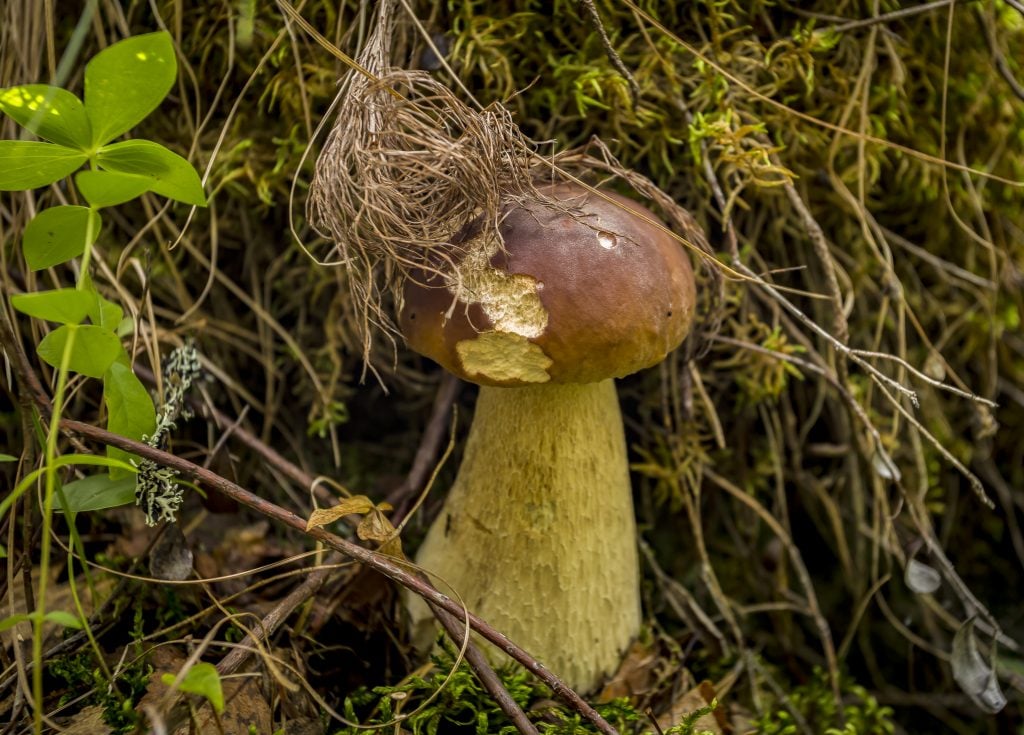
Nutrition and Health Benefits of Porcini Mushrooms
Porcini mushrooms are a healthy and well-balanced ingredient with lots of nutritious value. They’re high in protein with more than 30 grams per 100-gram serving. They contain more than 150% of the daily recommended amount of iron. They’re also very high in vitamin A and C.
With this nutrition profile, porcini mushrooms are a great meat alternative for vegetarians or those trying to cut down on their meat consumption. (Learn more about weather mushrooms are vegetables here.) They can also have some additional health benefits:
Weight loss aid – Since porcini mushrooms contain lots of fiber and protein, adding them to your diet will keep you feeling full for longer. Fiber helps to maintain gut health and promotes a feeling of fullness. Your body spends more energy breaking down protein than fat or carbohydrates, so you end up with less calories left over when you eat high-protein foods like porcini mushrooms.
High in antioxidants – Porcini mushrooms are a high antioxidant food just like dark chocolate, blueberries, artichokes and more. Some antioxidants found in porcini mushrooms include lycopene, ascorbic acid, and beta-carotene. Antioxidants help prevent damage to the body’s cells by neutralizing particles called free radicals which contribute to illness and aging.
No cholesterol, trans fat, or saturated fat – All three of these molecules can raise your body’s bad (LDL) cholesterol levels and increase your risk of heart disease. Red meats like beef and dairy products contain cholesterol. Even lean meats like chicken still contain some saturated fat. Eating porcini mushrooms is a good way to get your dietary protein or iron without the downside of raising your cholesterol like meat.
Reduces inflammation – Porcini mushrooms can reduce inflammation in your body. Inflammation is associated with many health problems ranging from arthritis and asthma to ulcers. Studies on mice treated with porcini mushroom extracts have shown decreased markers of inflammation.
Might kill colon cancer cells – Saying that mushrooms can cure cancer is a very bold claim to make. But there are some studies that are starting to suggest exactly that. Evidence is growing for mushrooms, including porcinis, as anti-cancer therapeutics. In some studies, porcini mushroom extract has been able to kill human colon cancer cells entirely. In others it blocks their growth and spread. The fact that porcini mushrooms are high in fiber also helps protect against colorectal cancer. While more research still needs to be done, if you have a family history of colon cancer, you may consider adding more porcini mushrooms to your diet.
For more delicious reasons to reach for mushrooms more often, read about the health and nutritional benefits of mushrooms.
Types of Porcini Mushrooms
There are a few different types of porcini mushrooms. They all look and taste quite similar with minor differences. Porcini D’Autunno is the most sought-after. Porcini Neri have a darker brown or blackish cap. Porcini del Freddos tend to be found in colder climates, while Porcini D’Estate are found in the summer in warmer climates.
Generally, when you purchase porcini mushrooms, there is no differentiation made between these different types. They will all simply be labeled as porcinis.
How to Substitute for Porcini Mushrooms
Since porcini mushrooms can be expensive and/or difficult to find, you may need to substitute other mushrooms for them sometimes.
In terms of texture and size, king trumpet mushrooms are a good substitute. In terms of taste, shiitake mushrooms are the most comparable.
For recipes that call for dried porcini, you can substitute for dried portobellos or shiitakes if you’re just looking to add a general mushroom flavor and texture to your recipe.
Differences Between Porcini and Shiitake Mushrooms
Shiitake mushrooms are just as meaty as porcini mushrooms and often less expensive to buy since they can be cultivated. They have a similar earthy flavor to porcinis. Some people say that shiitake mushrooms also have a slightly garlicky flavor.
While stems of porcini can be eaten, the stems of shiitake mushrooms are too tough. They can be used to flavor broths, but shouldn’t be used in dishes whole.
Unlike porcini, shiitake mushrooms are fairly easy to grow. Our article How To Grow Shiitake Mushrooms: The Ultimate Guide walks you through the process step-by-step.

Porcini History and Fun Facts
The name porcini means “piglets” or “little piggy” in Italian and refers to the way these mushrooms look quite stout and plump. Wild pigs enjoy eating the mushrooms which could also contribute to the name.
Cooking and eating porcini mushrooms goes back to at least the ancient Romans. They referred to them by their Latin name, boleti.
Porcini mushrooms have been enjoyed by royalty and aristocrats outside of Italy and across the rest of Europe too. The king of Sweden and Norway during the 18th century, Karl Johan XIV, was said to love porcini mushrooms so much that people in that country still refer to them as Karljohanssvamp to this day.
Here are some names for the porcini mushroom in various languages:
Can You Grow Porcini Mushrooms At Home?
Lots of websites sell porcini spores and claim that you can grow them at home, but generally this won’t work.
Porcini is very difficult to grow commercially or at home since they need tree roots to grow. They prefer a few specific species of trees in particular.
Even if you plant spores in the right location, porcini mushrooms are very slow growing. It takes 10 to 15 years from when the spores go into the ground until the mycelium will start producing mushrooms.
We advise against trying to grow porcini mushrooms at home simply because the chance of success is extremely low. You’re better spending that time looking for wild mushrooms, or simply buying them.
If you still want to try and grow your own porcinis, our article How To Grow Mushrooms Outdoors With A Mushroom Bed will have some useful general advice.
Conclusion
Porcini mushrooms are a sought-after ingredient for both Italian and French cuisine.
These mushrooms are difficult to grow commercially since they require a symbiotic relationship with tree roots to grow. As a result, fresh porcini mushrooms can only be harvested during a narrow window of time each year. However, dried porcinis can be bought year-round.
Porcini mushrooms are most often used in pasta and risotto. However they also make a great addition to soups, sauces, eggs, or can simply be fried up and eaten all on their own.
